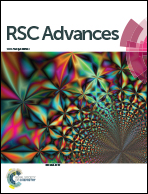Tuning surface accessibility and catalytic activity of Au nanoparticles through immobilization within porous-organic polymers†
Abstract
Herein, we outline a facile and promising approach in which microporous organic polymer matrices were constructed from their molecular building blocks, in the presence of surface-functionalized Au nanoparticles (AuNPs) as one component of the system. This approach permitted the construction of microporous networks around AuNPs and consequently allowed controlling access of small guest molecules to the surface of the AuNPs. Gas sorption measurements confirmed the permanent microporosity of the composites, and furthermore demonstrated interdependence between the size and degree of connectivity of the molecular linkers, the amount of AuNPs added to the initial reaction mixture, and porosity of the composites. A clear electrocatalytic activity dependence on the molecular size of the substrate and pore system of the host matrix is demonstrated. Of special significance is the enhanced catalytic activity of the investigated composites towards borohydride oxidation (mass activity of 8.8–12 mA mg−1) as compared to flat Au electrode (1.6 mA mg−1). These results show a versatile pathway to utilize decorated AuNPs, as functionalized building units, in construction of porous solids with hybrid composition and tunable properties.


 Please wait while we load your content...
Please wait while we load your content...